![]()
![]()
![]()
Use LEFT and RIGHT arrow keys to navigate between flashcards;
Use UP and DOWN arrow keys to flip the card;
H to show hint;
A reads text to speech;
62 Cards in this Set
- Front
- Back
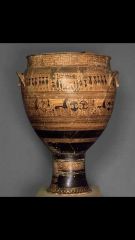
Geometric Krater from the Dipylon cemetery |
c.740 BCE Open at top and bottom (funerary) Ceramic, clay Additive sculpture Painted Hired mourners Sacrifical animals |
|
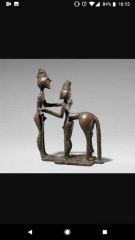
Hero and Centaur |
c.750 BCE Bronze (expensive) About 5 inches Found in Temple Hercules battle scene Celebrating individual ability w heroes
|
|

Temple of Hera I, Paestrum, Italy |
c. 550 BCE Sanctuary Marble |
|
|
Geometric Period |
c. 900 - 700 BCE Describes art style Homer Olympic games (began as religious ceremony) Polis = city |
|
|
Archaic period |
c. 600 - 480 BCE Art develops quickly Colonies in southern Italy "Old fashioned" |
|
|
Stylobate |
Base/stairs of a Greek temple |
|
|
Column |
Base, shaft, capital |
|
|
Entablature |
The section above the columms Architrave - the bottom strip frieze - middle (relief sculpture or triglyph & metope) cornice - top strip |
|
|
Triglyph and metope |
Grooved marble bands |
|
|
Pediment |
Triangular "roof" usually with relief sculpture |
|
|
Cella |
One enclosed part of the temple, Houses the statue of the god d |
|
|
Peristyle |
Perimeter of columns around the temple space, outside of the cella |
|
|
Entasis |
Columns bulge out in the middle |
|
|
Doric order |
No bases Triglyph and metope Earlier Simple captials |
|
|
Ionic order |
Bases Continuous relief sculpture frieze Later Scroll captials More elaborate |
|
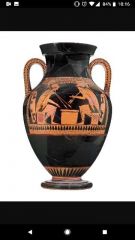
Exekais, Achilles and Ajax Playing a Game |
c. 540 BCE Fine art, the best Amphora (can get huge) Black-figure painting |
|
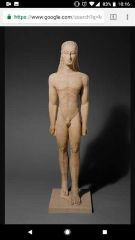
Metropolitan Kouros |
c. 600 BCE Youth Singular figure Grave marker or lined important routes (to temples) Same pose as Egyptian sculpture Individual accomplishment |
|
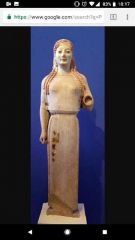
Peplos Kore |
c. 530 BCE Young woman Peplos = standard woman clothing Naturalism in face No idealization Archaic smile |
|

Kritios Boy |
480 BCE Transition between archaic and classical Kritios is sculptor About 3ft Inlaid eyes, prob crystal Strut helps brace arms Break with Egyptian/ naturalism Movement Weight distribution
|
|
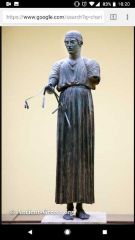
Charioteer |
c. 470 BCE Sanctuary of Apollo, Delphi Bronze 5'11 Part of 4 horse team Can hold it's own weight |
|
|
Amphora |
Funerary or used for wine Bell shaped vase with two handles Can get HUGE |
|
|
Black-figure painting |
Earliest technique dominant in archaic period |
|
|
Archaic smile |
Shows they are alive Motion and emotion |
|
|
Lost-wax casting |
Hollow Clay version of figure Cover clay with wax Investment outside of wax (non flammable) Bury sculpture Melt bronze and pour in wax channel |
|
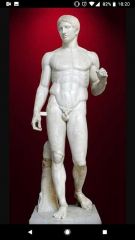
Polykleitos, Doryphoros (Spear Bearer) |
c. 450 BCE Compliment to his book "perfect form" Cannon of proportions Originally in bronze Contrapposto |
|
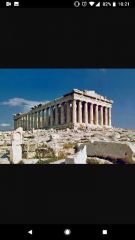
Parthenon, Athens Kallikrates & Iktinos |
440 BCE Athena Parthenos - virgin 40ft tall statue, guilded ivory clothes Metopes with high relief Doric order outside Inner paristyle almost ionic frieze Panathenaic procession - 4 year peplos weaving |
|
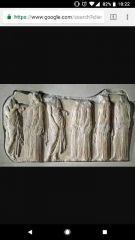
Marshals and Young Women, East ionic frieze |
c. 440 BCE Parthenon Pheidias - Parthenon sculpture master Regular people, real event on temple Elaborate drapery |
|

Erechtheion, Athens |
c. 420 BCE Ionic order Porch of the maidens - caryatid Athena Olive tree nearby |
|

Dying Gaul |
c. 230 BCE Pergamon Trumpeter Trying to get up - worthy opponent Emotional |
|
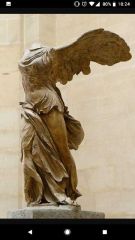
Nike of Samothrace |
c. 190 BCE Original location - north agean Goddess of victory Naval victory - full scale battleship w waves crashing on top of a mountain Fully in motion Over 8ft No struts needed - counterbalance Wet drapery |
|
|
Classical Period |
480- 323 BCE Increased naturalism Break from Egyptian idealization Increased movement Contrapposto |
|
|
Hellenistic period |
After 323 BCE Greek-like, global Alexander the great Narrative Over the topNarrativeMulti figure groups topNarrativeMulti figure groups Multi figure groups |
|
|
Acropolis |
High city Classical period Perikles - important Athenian Main temple Parthenon Monumental gateway |
|
|
Contrapposto |
An X counterbalance of arms and legs |
|
|
Caryatid |
Column designed to look like human figure |
|
|
Wet drapery |
Wet cloth, transparent and clinging to skin |
|
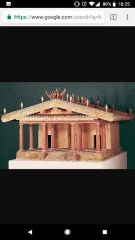
Model of an Etruscan temple |
Columns on porch Sculpture on roof One set of stairs 3 cellas (Tinia, uni, and menura) Wood and clay |
|
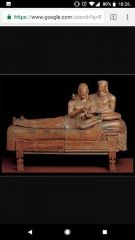
Reclining couple sarcophagus |
c. 520 BCE Terra cotta Archaic smiles Dinner Happy and talking Not naturalistic |
|
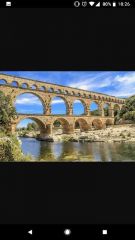
Pont du Gard, Nimes, France |
c. 16 BCE Aqueduct Infrastructure from army Beauty and function Culture of water |
|
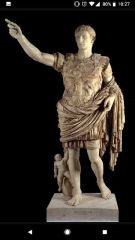
Augustus of Primaporta |
c. 0 CE Functions like stele Many copies Holds metal rod - senators talking Stick Cupid figure - dependant of Venus Military general - celebrating victory Speaking to troops gesture Same legs as doryphorus Idealized Portrait |
|

Ara Pacis Augustae |
10 BCE Alter of Augustan peace
Religious altar Parade army's, loot, and execute prisoner Greatest honor monument Religious altar Parade army's, loot, and execute prisoner Two story relief sculptures Abstract vegetal and historical scenes
|
|
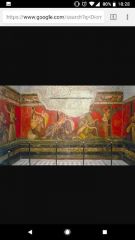
Dionysiac mystery frieze, Villa of the Mysteries, Pompeii |
c. 60-50 BCE Initiation rites of the cult of Bacchus Alternative religion, strange iconography |
|
|
Etruscans |
Absorbed into Roman culture Close with archaic Greeks Roman's wrote about |
|
|
Terra cotta |
Type of clay |
|
|
Aqueduct |
Water transportation system |
|
|
Keystone |
Apex Stone of round arch |
|
|
Voussoir |
Stones of the arch |
|
|
Caesar Augustus |
Turned Rome from brick to marble Propaganda |
|

Colosseum (Flavian Amphitheater) Rome |
70 BCE Double theater Blood sports Flooded for mock naval battles Built in 10 years as propaganda Strength of flavians |
|
|
Flavians |
Gave Nero's palace land back to people Built colloseum |
|
|
Barrel vault |
Round arches forming hallway |
|
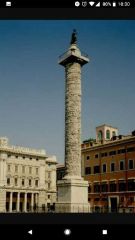
Column of Trajan, Rome |
112 CE 125ft tall 625ft continuous reliefs Celebrating Pacian war triumph Trajans tomb Taken over and replaced trajan with St.Peter Meant to be viewed from libraries |
|
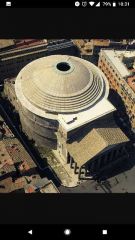
Pantheon, Rome |
c. 125 CE All the gods; Etruscan culture Best surviving Hadrian built Marcus Agrippa - tie to Augustus, long standing culture
Rotunda Drum dome Oculus Coffer Cosmic |
|

Commodus as Hercules |
c. 191-192 CE Declares himself reincarnation of herc Lost Roman ruler traditions Beginning of the end Ruled 11 years before assassination Idealized Hellenistic Drillwork |
|
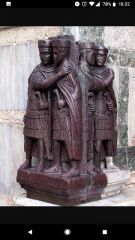
Tetrarchs |
c. 305 CE Porphyry - purple material, imperial family color Same level, 4 emperor's Propaganda reassuring power and unity Discontines Greek sophistication |
|
|
Forum |
Economic, religious, political, market center Everything all in one place |
|
|
Hadrian |
Ruled 117-138 BCE Greek and Egyptian culture Modelled himself by Greek philosopher Beard Little greekling Spanish general, chosen by merit |
|
|
Drum |
Circular set of concrete load bearing walls |
|
|
Coffers |
Recessed squares to reduce weight |
|
|
Drillwork |
Hand drill tool used to make negative space |
|
|
Porphyry |
Purple material color of imperial family |
|
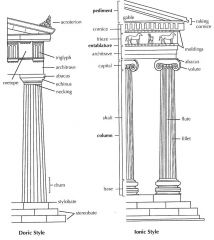
Greek Temple Diagram |
😎 |

